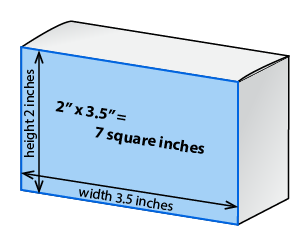This is part of the Labeling Basics series in which I am taking labeling back to its most fundamental parts, starting with the legal terms used and then going on to each requirement for soap and cosmetic labels.
In labeling, the size and placement of the principal display panel determines where certain information must be placed and what size the text must be.
Key Words to Know
Principal
Of a thing: first, chief, most important.
Display Panel
A separate or distinct part of a surface on which information can be shown.
Which brings us to the legal definition of Principal Display Panel (“PDP”):
Directly from the regulations:
The part of a label that is most likely to be displayed, presented, shown, or examined under normal and customary conditions of display for retail sale.
16 CFR 500.2(h) and 21 CFR 701.10
Usually the PDP is the front panel of the package or container. It is what the consumers see as they walk by or what they would be most likely to read first when picking up and inspecting the product.

The PDP must be large enough to accommodate all the mandatory label information clearly and conspicuously and without any obscuring designs, pictures, or crowding.[[21 CFR 701.10]]
If the actual product container is inside a box, only the outer package (in this case, the box) would have a PDP.1
Calculating the Size of the PDP
The size of the PDP can be calculated in square inches. (Remember from basic geometry that the area of a rectangle is obtained by multiplying the height by the width.)
Rectangular Package
For a rectangular package or container, the principal display panel is one entire side.2 The size is calculated as the width x height of that side.3
height x width = PDP
Example: For a soap box that is 2 inches high and 3.5 inches wide, the PDP is calculated as:
2 inches x 3.5 inches = 7 square inches.

Cylindrical Container
For the PDP of a cylindrical container, the PDP size is 40% of the entire surface (excluding shoulder and neck). It is calculated by multiplying the height times the circumference and then calculating 40% (which you obtain by multiplying by 0.4) of that space.4
Key Word to Know
Circumference:
The measurement around a round or circular object.
(height x circumference) x 40% = PDP of a cylindrical container
Example: A bottle that is 3 inches high and 6 inches around would be calculated as:
(3 inches x 6 inches) x 0.40 = 7.2 square inches

Otherwise Shaped Containers
In the case of any otherwise shaped container or commodity, the PDP is 40% of the total surface space. HOWEVER, if there is a side or panel that is an obvious principal panel, such as one side of a triangular shaped box, then that would be considered the entire PDP.5
Very Small Containers
Very small containers (for example, a 1/4 oz. vial) may use a tear-away tag or tape to present the required information. In that case, the PDP size is determined by the container itself. If the small container is attached to a larger card which contains the necessary information, then the card to which the container is attached is considered the PDP.6
Why is this Important?
The size of the principal display panel is used to determine:
- The required text size of the statement of net contents
- The placement of the statement of net contents




Leave a Reply